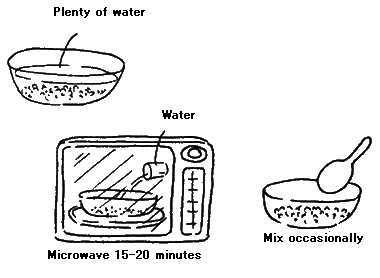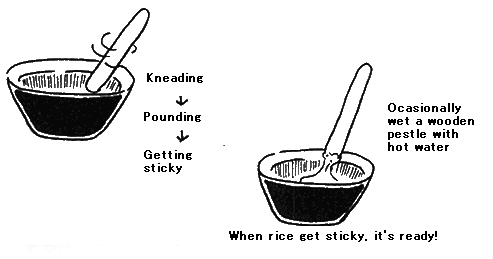Internet Version [Naruhodo no Mori] Vol.55
by Yumiko Mori

Vol.55 January 15th, 2001
Mochitsuki (Rice cake making)
New Century: My Thought
Home science experiments for mothers of elementary school children


Mom: "Shall we make rice cake?"
Tae: "What?
How can we pound rice cake at home?"
Mom: "We can pound rice cake with a mortar and a pestle."
Tae: "That sounds interesting!
I will help you."
First, we microwave glutinous rice.
Then we start pounding the heated rice.
Satoshi: "Can I do first?"
Mom: "First, you have to knead rice."
Tae: "Satoshi, I can hold this mortar while you pound rice."
Satoshi keeps pounding with a wooden pestle.
It is easy to pound at the beginning, but later the rice gets very sticky.
Satoshi: "I am getting tired.
This is very heavy now."
Tae: "You can't pound any more?
Let me do it."
Satoshi: "Tae, you are strong!"
If you no longer see grain shapes in the rice cake, it is probably ready.
It's time to eat!
We put two toppings, anko (Japanese bean jam) and kinako (soy bean flour), on rice cakes.
Mom: "Do you know we can not make rice cake from normal rice because it doesn't get sticky enough.
Glutinous rice is 100% amylopectin.
That's why it is so sticky.
On the other hand, normal rice contains amylose."
Tae: "This rice cake is very good.
It was worth the effort.
I am very satisfied."
| Glutinous rice | 1 cup |
| An earthenware mortar | |
| A wooden pestle and a wooden spoon | |
| Microwave oven | |
| A deep dish and a sieve | |
| Toppings for rice cakes | kinako (yellow soy bean flour), anko (red bean paste), grated daikon radish nori (Japanese seaweed), sugar, soy sauce |
| Dishes and chop sticks | |



* It's too tiring to do mochitsuki by yourself.
It's the best to do mochitsuki when your friends can help you.
"Mochitsuki" may not be regarded as a science experiment. But I believe not many children have experienced mochitsuki. Occasionally mochitsuki events are held in Japanese preschools, but most parents don't know how to do mochitsuki. I had imagined mochitsuki needs a lot of preparation and work. I am glad to find this easy way to pound rice cake. Using this method, we can do mochitsuki more frequently. I hope you will try this easy mochitsuki.
Recently an antenna tower for mobile phones was built within the elementary school yard. Some of the parents who were notified afterwards wanted to remove the antenna from the school. I asked other people and went to a nearby library to check what exactly electromagnetic waves are. I am always interested in science experiments, but embarrassingly I didn't know much about electromagnetic waves. One of my friends, who seems to know what human being really needs, has quickly declared "We don't need this antenna." I was less efficient in deciding whether I should be against the antenna and felt envious of the friend. While I am pondering about such problems, I worry more urbanization will continue in my town.
| Author | Yumiko Mori (Zushi, Kanagawa, Japan) |
|---|---|
| Illustration | Mitsue Ogata |
| Translator | Akira Ishihara |
| HTML format | Muneo Kume |

